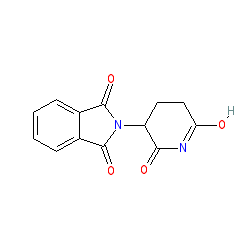GtoPdb is requesting financial support from commercial users. Please see our sustainability page for more information.
|
Synonyms: K-17
thalidomide is an approved drug (FDA (1998), EMA (2008))
Compound class:
Synthetic organic
Comment: Thalidomide is principally an immunomodulatory drug. It inhibits synthesis of TNFα. Mechanistically, thalidomide binds to cereblon, and this complex recruits substrate proteins for degradation by the ubiquitin system. The lymphoid transcription factors Ikaros (IKZF1) and Aiolos (IKZF3) have been identified as substrates for thalidomide-bound cereblon. More recently another transcription factor, PLZF (ZBTB16), has been reported as a potential thalidomide/cereblon substrate [7]. Knockdown of Plfz induces skeletal abnormalities in chicken limbs, so thalidomide-targeted degradation of PLZF would be predicted to exhibit similar teratogenic effects.
SARS-CoV-2 and COVID-19: Thalidomide + low-dose glucocorticoid is being evaluated for efficacy in severe COVID-19 pneumonia (preprint available here https://www.preprints.org/manuscript/202002.0395/v1). An alternative approach is examining the combination of thalidomide + celecoxib (which targets NF-κB to suppress production of inflammatory cytokines; see preprint DOI: 10.13140/RG.2.2.26979.91689). Ligand Activity Visualisation ChartsThese are box plot that provide a unique visualisation, summarising all the activity data for a ligand taken from ChEMBL and GtoPdb across multiple targets and species. Click on a plot to see the median, interquartile range, low and high data points. A value of zero indicates that no data are available. A separate chart is created for each target, and where possible the algorithm tries to merge ChEMBL and GtoPdb targets by matching them on name and UniProt accession, for each available species. However, please note that inconsistency in naming of targets may lead to data for the same target being reported across multiple charts. ✖ |
|
|||||||||||||||||||||||||||||||||||
| References |
|
1. Eichner R, Heider M, Fernández-Sáiz V, van Bebber F, Garz AK, Lemeer S, Rudelius M, Targosz BS, Jacobs L, Knorn AM et al.. (2016)
Immunomodulatory drugs disrupt the cereblon-CD147-MCT1 axis to exert antitumor activity and teratogenicity. Nat Med, 22 (7): 735-43. [PMID:27294876] |
|
2. Ito T, Ando H, Suzuki T, Ogura T, Hotta K, Imamura Y, Yamaguchi Y, Handa H. (2010)
Identification of a primary target of thalidomide teratogenicity. Science, 327 (5971): 1345-50. [PMID:20223979] |
|
3. Jo S, Lee KH, Song S, Jung YK, Park CS. (2005)
Identification and functional characterization of cereblon as a binding protein for large-conductance calcium-activated potassium channel in rat brain. J Neurochem, 94 (5): 1212-24. [PMID:16045448] |
|
4. Lopez-Girona A, Mendy D, Ito T, Miller K, Gandhi AK, Kang J, Karasawa S, Carmel G, Jackson P, Abbasian M et al.. (2012)
Cereblon is a direct protein target for immunomodulatory and antiproliferative activities of lenalidomide and pomalidomide. Leukemia, 26 (11): 2326-35. [PMID:22552008] |
|
5. Mazzoccoli L, Cadoso SH, Amarante GW, de Souza MV, Domingues R, Machado MA, de Almeida MV, Teixeira HC. (2012)
Novel thalidomide analogues from diamines inhibit pro-inflammatory cytokine production and CD80 expression while enhancing IL-10. Biomed Pharmacother, 66 (5): 323-9. [PMID:22770990] |
|
6. Xin W, Xiaohua N, Peilin C, Xin C, Yaqiong S, Qihan W. (2008)
Primary function analysis of human mental retardation related gene CRBN. Mol Biol Rep, 35 (2): 251-6. [PMID:17380424] |
|
7. Yamanaka S, Murai H, Saito D, Abe G, Tokunaga E, Iwasaki T, Takahashi H, Takeda H, Suzuki T, Shibata N et al.. (2020)
PLZF is a new substrate of CRBN with thalidomide and 5-hydroxythalidomide. bioRxiv, preprint. DOI: 10.1101/2020.02.28.969071 |









